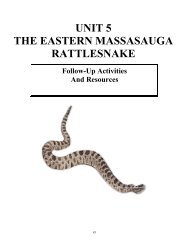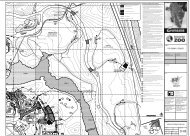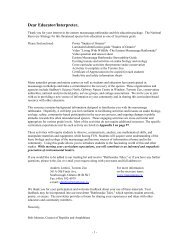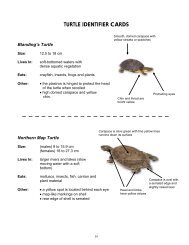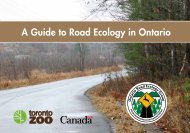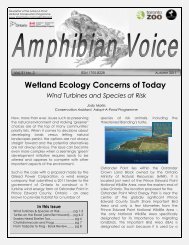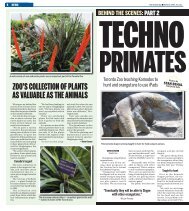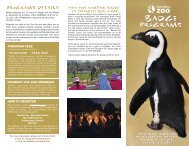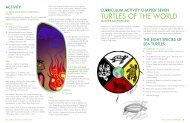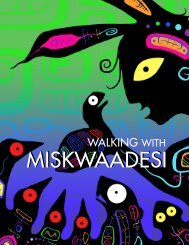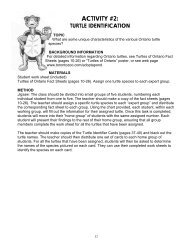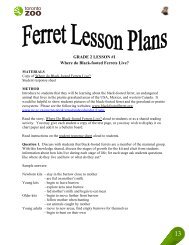UNIT 1 SNAKE BIOLOGY - Toronto Zoo
UNIT 1 SNAKE BIOLOGY - Toronto Zoo
UNIT 1 SNAKE BIOLOGY - Toronto Zoo
You also want an ePaper? Increase the reach of your titles
YUMPU automatically turns print PDFs into web optimized ePapers that Google loves.
<strong>UNIT</strong> 1<br />
<strong>SNAKE</strong> <strong>BIOLOGY</strong><br />
Introduction to the<br />
Amazing Biology of<br />
Rattlesnakes<br />
17
Rattlesnake Curriculum Resource<br />
Unit 1: Snake Biology<br />
Teacher Resource<br />
SECTION 1:<br />
Ectotherms<br />
Activity 1.1 Monstrous Appetites<br />
Science and Technology - Life Systems<br />
Grade 1: Characteristics and Needs of<br />
Living Things<br />
Grade 6: Diversity of Living Things<br />
Grade 7: Interactions within Ecosystems<br />
Mathematics - Data Management and Probability Grade 1<br />
Grade 6<br />
Grade 7<br />
19
ECTOTHERMS!<br />
INTRODUCTION<br />
Reptiles require warmth just like us. Adequate heat is essential for proper digestion and other<br />
biological processes. They use different strategies to acquire heat, maintain heat, or alter body<br />
temperature. Reptiles make efficient use of their food energy, none of which is used to keep their<br />
bodies warm.<br />
Ectotherms<br />
Snakes are reptiles and all reptiles are ectothermic (ecto = from the outside, thermic =<br />
temperature). This means that they obtain body heat from their environment.<br />
Mammals vs. Ectotherms<br />
Mammals, such as humans, are endothermic (endo = from the inside, thermic = temperature) or<br />
warm-blooded. We control our body temperatures internally. To stay warm, mammals convert<br />
food into metabolic and mechanical energy. Relatively large amounts of heat energy are released<br />
into the atmosphere in this process. Therefore, mammals must continually eat; furthermore,<br />
mammals have to eat more than reptiles do. Reptiles require 90% less energy than mammals.<br />
Behavioural Thermoregulation<br />
The term cold-blooded, often used to describe reptiles, is misleading because the blood of a<br />
reptile is not necessarily cold. In fact, by varying their exposure to the sun or shade, reptiles can<br />
raise or lower their body temperature to maintain a prefered body temperature. This process is<br />
called behavioural thermoregulation. Snakes can also absorb radiant heat reflected off the ground<br />
or surrounding objects.<br />
How do reptiles keep warm?<br />
Basking in the sun is the most effective and common strategy reptiles use to keep warm. Rattlesnakes are<br />
often found on pathways, open rock areas, or in clearings, especially in the summer. Snakes can stay warm<br />
at night by seeking shelter under warm rocks, and can cool off during the day by moving into the shade.<br />
Physiological changes facilitate the transfer of heat to their bodies.<br />
Why do reptiles need heat?<br />
Snakes must increase their body temperature to obtain and digest food, excrete waste, and<br />
maintain respiration and circulation, functions that are essential to life. Their bodies must be<br />
warm to keep them active and alert. As well, female rattlesnakes use the warmth of the sun to<br />
incubate their internally developing embryos.<br />
20
Rattlesnake Curriculum Resource<br />
Unit 1: Snake Biology<br />
Teacher Resource<br />
ACTIVITY 1.1<br />
Monstrous Appetites<br />
ISSUE<br />
How do the energy requirements, food intake, and overall efficiency of mammals and reptiles<br />
compare?<br />
BACKGROUND INFORMATION<br />
Animals use energy gained from food for many different activities. Reptiles and mammals have<br />
different lifestyles and survival strategies. Lets compare reptiles and mammals…<br />
Reptiles, such as snakes, save a lot of energy being ectothermic (“ecto”- from outside and<br />
“thermic”- heat). They do not use energy from their food to keep their bodies warm. This<br />
strategy allows them to use energy for essential biological functions such as metabolism<br />
(digestion, absorption, excretion), respiration, circulation, and reproduction. In fact, snakes<br />
require 90% less energy than mammals! Reptiles hibernate during the winter and do not eat<br />
during this period.<br />
If you (a mammal) needed to eat 3 meals every day to stay alive, you would eat:<br />
• 21 meals in a week (3 meals per day times 7 days per week)<br />
• 90 meals in a month (3 meals per day times 30 days in a month)<br />
• 1095 meals in a year (3 meals per day times 365 days in a year)<br />
If a snake (a reptile) ate the same food but only needed to consume 10% of what you ate, it would<br />
eat:<br />
• 2 meals in a week<br />
• 9 meals in a month<br />
• 110 meals in a year<br />
21
Rattlesnake Curriculum Resource<br />
Unit 1: Snake Biology<br />
Student Activity Sheet- Primary<br />
Name:_______________________<br />
Date:________________________<br />
ACTIVITY 1.1<br />
Monstrous Appetites (Continued)<br />
QUESTIONS<br />
1. Draw lines to show what the people eat and what the snake eats.<br />
2. Look at the pictograph below and answer the following questions:<br />
a) How many meals in a week does a snake eat? ______________________<br />
b) How many meals in a week does a person eat? ______________________<br />
c) Who eats more in a week (a snake or a person)? ______________________<br />
22
Rattlesnake Curriculum Resource<br />
Unit 1: Snake Biology<br />
Teacher Resource- Answer Sheet- Primary<br />
ACTIVITY 1.1<br />
Monstrous Appetites (Continued)<br />
ANSWERS<br />
1. Draw lines to show what the people eat and what the snake eats.<br />
Humans eat Apples, Cookies and Cheese.<br />
Snakes eat Frogs, Mice and Birds<br />
2. Look at the pictograph below and answer the following questions:<br />
a) How many meals does a snake eat? TWO<br />
b) How many meals does a person eat? TWENTY-ONE<br />
c) Who eats more (a snake or a person)? A PERSON<br />
<strong>SNAKE</strong>S<br />
HUMANS<br />
23
Rattlesnake Curriculum Resource<br />
Unit 1: Snake Biology<br />
Student Activity Sheet- Junior<br />
Name:______________________<br />
Date:_______________________<br />
ACTIVITY 1.1<br />
Monstrous Appetites (Continued)<br />
QUESTIONS<br />
1. Scientists gathered information on the number of meals snakes eat and compared these results<br />
to humans. Their results are shown in the table below:<br />
Humans Snakes<br />
Week 21 2<br />
Month 90 9<br />
Year 1095 110<br />
a) Create a bar graph from these results. (Remember to include a title and label the axis.)<br />
b) Looking at your graph, which type of animal makes most efficient use of their<br />
food energy (you or the snake)? Why?<br />
______________________________________________________________________________<br />
______________________________________________________________________________<br />
______________________________________________________________________________<br />
______________________________________________________________________________<br />
2. Snakes are cold-blooded (ectothermic) animals. What does the term “cold-blooded” mean?<br />
______________________________________________________________________________<br />
______________________________________________________________________________<br />
______________________________________________________________________________<br />
______________________________________________________________________________<br />
3. Using your knowledge about cold-blooded animals, why do snakes eat less food than<br />
humans?<br />
______________________________________________________________________________<br />
______________________________________________________________________________<br />
______________________________________________________________________________<br />
______________________________________________________________________________<br />
4. A raccoon and a snake have landed on an island in Georgian Bay. If food were scarce, which<br />
animal would survive longer? Why?<br />
______________________________________________________________________________<br />
______________________________________________________________________________<br />
______________________________________________________________________________<br />
______________________________________________________________________________<br />
24
Rattlesnake Curriculum Resource<br />
Unit 1: Snake Biology<br />
Teacher Resource- Answer Sheet- Junior<br />
ANSWERS<br />
ACTIVITY 1.1<br />
Monstrous Appetites (Continued)<br />
1. Scientists gathered information on the number of meals snakes eat and compared these results<br />
to humans. Their results are shown in the table below:<br />
Humans Snakes<br />
Week 21 2<br />
Month 90 9<br />
Year 1095 110<br />
a) Create a bar graph from these results. (Remember to include a title and label the axis.)<br />
Student answers will vary.<br />
b) Looking at your graph, which type of animal makes most efficient use of their<br />
food energy (you or the snake)? Why?<br />
A reptile makes most efficient use of its food energy. (They are 90% more efficient than<br />
mammals.) It can keep warm by basking in the sun and can go longer between meals.<br />
2. Snakes are cold-blooded (ectothermic) animals. What does the term “cold-blooded” mean?<br />
Cold-blooded animals obtain heat from their environment.<br />
3. Using your knowledge about cold-blooded animals, why do snakes eat less food than<br />
humans?<br />
Snakes do not need to eat in order to maintain their body temperature because they use<br />
heat from the environment. As a result, they require less food.<br />
4. A raccoon and a snake have landed on an island in Georgian Bay. If food were scarce, which<br />
animal would survive longer? Why?<br />
If food were the only scarcity, the snake would have a better chance of survival than the<br />
raccoon because it needs less energy from the island’s limited prey resource. Snakes do<br />
not need to eat in order to maintain their body temperature because they use heat from the<br />
environment. As a result, they require less food.<br />
25
Rattlesnake Curriculum Resource<br />
Unit 1: Snake Biology<br />
Teacher Resource<br />
SECTION 2:<br />
Snakeskin<br />
Activity 2.1: Making Scales!<br />
Science and Technology - Life Systems<br />
Science and Technology - Structures<br />
and Mechanisms<br />
Grade 1, Characteristics and Needs of<br />
Living Things<br />
Grade 2, Growth and Changes in<br />
Animals<br />
Grade 5, Human Organ Systems<br />
Grade 6, Diversity of Living Things<br />
Grade 1, Everyday Structures<br />
The Arts - Visual Arts Grade 1<br />
Grade 2<br />
Grade 5<br />
Grade 6<br />
Activity 2.2: Snakeskin Shedding Speedway<br />
Science and Technology - Life Systems<br />
Health and Physical Education - Active<br />
Participation, Fundamental Movement Skills Grade 1<br />
Grade 2<br />
Grade 4<br />
Grade 6<br />
Activity 2.3: The Great Snake Detective<br />
Science and Technology - Life Systems<br />
Grade 1, Characteristics and Needs of<br />
Living Things<br />
Grade 2, Growth and Changes in<br />
Animals<br />
Grade 4, Habitats and Communities<br />
Grade 6, Diversity of Living Things<br />
Grade 2, Growth and Changes in<br />
Animals<br />
26
Rattlesnake Curriculum Resource<br />
Unit 1: Snake Biology<br />
Teacher Resource<br />
<strong>SNAKE</strong>SKIN!<br />
INTRODUCTION<br />
Skin is very important to rattlesnakes because it offers physical protection and its colours provide<br />
camouflage. Snakes shed their skin as they grow. As a snake gets older, its growth rate slows<br />
down, followed by fewer sheds per year. Shedding also helps to replace the top layer of skin that<br />
gets damaged by day to day activity. This new skin offers better protection to the snake.<br />
LAYERS<br />
Snakes have three layers of skin. The outer layer is very thin and clear, providing the snake with<br />
extra protection. This outer layer is shed and replaced several times a year. The middle layer is<br />
thick and very tough. It contains thousands of hard overlapping scales, which act like armour.<br />
The scales overlap, providing leeway for expansion as the snake moves or when the snake<br />
consumes a large meal. The middle layer also grows the new skin before the snake sheds its old<br />
outer layer. The bottom layer of skin is the thickest and it contains the pigment that shows<br />
through the top two clear layers as distinct colours and patterns. The snake needs this pigment to<br />
hide itself in its environment.<br />
27
Figure 6: Human skin in cross-section<br />
Figure 7a: Snakeskin in cross section<br />
28
Rattlesnake Curriculum Resource<br />
Unit 1: Snake Biology<br />
Teacher Resource<br />
EYELIDS<br />
Snakes have no eyelids and cannot blink. Their eyes are protected by a thin layer of skin called<br />
the spectacle. Spectacles are shed along with the outer layer of skin.<br />
THE SHEDDING PROCESS (ECDYSIS)<br />
When a snake prepares to shed its old skin, a milky liquid builds up under the outer layer to<br />
loosen it from the new layer of skin formed below. This milky film leaves a grey appearance to<br />
the snake’s eyes and the dark belly scales on a rattlesnake. Snakes are vulnerable at this time and<br />
generally try to hide.<br />
To begin shedding, the snake rubs its head against something hard to split the skin. By flexing its<br />
muscles, the snake stretches the outer skin and begins to wriggle out. The snake helps to pull the<br />
old skin back by curling around objects such as logs, branches, and stones. Eventually the outer<br />
skin is left behind, usually in one piece and inside out. The new skin is shiny and the snake's<br />
colours and patterns appear brighter than ever! Also, a new segment is added to the rattle each<br />
time a rattlesnake sheds - 3 to 4 times a year. You may find shed skins wrapped around logs,<br />
rocks, or near old building foundations. Shed skins are clear and engraved with the outline of<br />
every scale and fold of the snake's skin, including the spectacles that cover the eyes. The snake's<br />
pattern may also be visible on this discarded skin. Shed skins may be used to identify the snakes<br />
in a surrounding area.<br />
Figure 7b:Each rattlesnake has a unique pattern. <strong>Toronto</strong> <strong>Zoo</strong> uses the shed skin to<br />
identify snakes<br />
29
Rattlesnake Curriculum Resource<br />
Unit 1: Snake Biology<br />
Teacher Resource<br />
Figure 8-11: Snake shedding its skin. Note the use of natural objects to break and peel<br />
off the skin.<br />
30
Rattlesnake Curriculum Resource<br />
Unit 1: Snake Biology<br />
Teacher Resource<br />
SCALES<br />
All reptiles have scales, but not all scales are the same. Snakes can either have smooth scales or<br />
keeled scales. The kind of scales a snake has gives us an important clue in its identification.<br />
Smooth scales give the snake a shiny, sleek appearance. Keeled scales have a raised ridge along<br />
their mid-line, giving the snake a rough-textured appearance. Can you tell which kind of scale<br />
the massasauga rattlesnake has by its picture on the "Snakes of Ontario" poster? (The<br />
massasauga has keeled scales.) From the poster, make a list of all the snakes that have keeled<br />
scales, and all the snakes that have smooth scales.<br />
Figure 12: Snake shedding its head scales. Note the outline of each scale and spectacle.<br />
31
Rattlesnake Curriculum Resource<br />
Unit 1: Snake Biology<br />
Teacher Resource<br />
SMOOTH SCALES<br />
Northern Ringneck Snake<br />
Smooth Green Snake<br />
Blue Racer<br />
Northern Water Snake<br />
KEELED OR WEAKLY KEELED<br />
SCALES<br />
Eastern Massasauga Rattlesnake<br />
Northern Brown Snake<br />
Northern Redbelly Snake<br />
Queen Snake<br />
Eastern Garter Snake<br />
Northern Ribbon Snake<br />
Eastern Hognose Snake<br />
Figure 13: Smooth snake scales<br />
Figure 14: Keeled scales of the<br />
massasauga rattlesnake<br />
CAMOUFLAGE<br />
Patterns on snakes help them to hide from their predators by blending into their surroundings or<br />
breaking up their shape in light and shadow. Colours and patterns also help us to distinguish one<br />
snake from another. Ontario's snakes can be grouped into three different pattern types: no<br />
pattern, striped, or blotched. Study the different patterns and colours on the "Snakes of Ontario"<br />
poster. How might these patterns help the snakes to hide in different habitats: peat bogs near<br />
Wainfleet, prairies in Windsor / La Salle; or forests and rocky outcrops on the Bruce Peninsula<br />
and around Georgian Bay.<br />
32
Rattlesnake Curriculum Resource<br />
Unit 1: Snake Biology<br />
Student Activity Sheet- Junior<br />
Name:_______________________<br />
Date:________________________<br />
ACTIVITY 2.1<br />
MAKING SCALES<br />
ISSUE<br />
What are the different scale types found in Ontario snakes?<br />
BACKGROUND INFORMATION<br />
Snakes have smooth or keeled scales. Different types of scales help us to identify different types<br />
of snakes. In this activity students will make a snake with smooth scales, using pumpkin seeds,<br />
and a snake with keeled scales, using sunflower seeds, so that they can gain an understanding of<br />
the difference between the two.<br />
MATERIALS<br />
2 lumps of Play-Doh, Silly Putty, etc.<br />
2 sheets of thin cardboard or heavy paper<br />
1 package of sunflower seeds (with shells)<br />
1 package of pumpkin seeds<br />
METHOD<br />
1. Roll out the clay into a snake shape, about 3 centimetres wide and stick it down on the<br />
cardboard.<br />
2. Shape the head and tail. Add a tongue for fun!<br />
3. Starting at the tail end, stick the sunflower seeds flat (broadside) down into snake’s back.<br />
Put the seeds as close together as possible. The second row will overlap the first row.<br />
Continue adding rows of seeds until you run out of seeds (each student group may need to<br />
use only a handful of seeds to make comparisons).<br />
4. Repeat steps 1 to 3, using pumpkin seeds instead of sunflower seeds, to create a second<br />
snake.<br />
33
Rattlesnake Curriculum Resource<br />
Unit 1: Snake Biology<br />
Student Activity Sheet- Junior<br />
Name:_______________________<br />
Date:________________________<br />
ACTIVITY 2.1<br />
MAKING SCALES (Continued)<br />
QUESTIONS<br />
1. Compare the two snakes. How do they look? How do they feel?<br />
_____________________________________________________________________________<br />
_____________________________________________________________________________<br />
_____________________________________________________________________________<br />
_____________________________________________________________________________<br />
2. Look at the “Snakes of Ontario” poster.<br />
a) Name a snake with smooth scales. ________________________________<br />
b) Name a snake with keeled scales. ________________________________<br />
c) What type of scales does the Eastern<br />
Massasauga Rattlesnake have? ________________________________<br />
ANSWERS<br />
1. Compare the two snakes. How do they look? How do they feel?<br />
Answers will vary.<br />
2. Look at the “Snakes of Ontario” poster.<br />
a) Name a snake with smooth scales. Various Answers.<br />
Examples: Eastern Milk, Northern Ringneck, Smooth Green, etc.<br />
b) Name a snake with keeled scales. Various Answers.<br />
Examples: Northern Water Snake, Eastern Hog Nose, Eastern Fox, etc.<br />
c) What type of scales does the Eastern<br />
Massasauga Rattlesnake have? Keeled Scales<br />
34
Rattlesnake Curriculum Resource<br />
Unit 1: Snake Biology<br />
Teacher Resource<br />
ACTIVITY 2.2<br />
<strong>SNAKE</strong>SKIN SHEDDING SPEEDWAY<br />
This fun game simulates skin shedding and incorporates some physical activity into the day (but<br />
you will need a bit of room).<br />
The members of each group must line up one in front of the other, back to front. The first person<br />
in the line will be the snake's head, and the last person in the line is the tail. The "head" of the<br />
snake must bend over and put his/her right hand back between his/her legs. The second person<br />
bends over and grabs the "head's" right hand with his/her left hand, and puts his/her right hand<br />
back between his/her legs. The whole line or "snake" joins up in this fashion. (i.e. left hand<br />
reaching forward and right hand reaching backward.)<br />
At the count of three, start shedding! The head of the snake begins to walk backwards, straddling<br />
over top of those crouched behind him/her. When the second person has been passed over, he/she<br />
then begins to straddle back over the rest of the snake's body, and so on until the snake's tail<br />
reaches the front and becomes the head. The skin is now shed!<br />
Later, you can have skin shedding races between groups, or increase the challenge by combining<br />
the groups to make longer snakes.<br />
Snakeskin Shedding Speedway Activity Set-up<br />
35
Rattlesnake Curriculum Resource<br />
Unit 1: Snake Biology<br />
Teacher Resource<br />
ACTIVITY 2.2<br />
<strong>SNAKE</strong>SKIN SHEDDING SPEEDWAY<br />
(Continued)<br />
Extension Exercise for Grades 4 and 6<br />
This activity simulates skin shedding in a time and space efficient manner.<br />
Have students put a long sock or stocking on one arm, pulling it all the way up to their biceps.<br />
These articles of clothing are used for protection and hug the body the same way as a snake's<br />
skin! Without using any hands (because snakes have no hands) "shed" the sock off, starting from<br />
the open end (mouth of the snake). Ask students to explore what objects (books, desks,<br />
smooth/rough surfaces, clothes, etc.) are most helpful with shedding their skin. Experiment with<br />
different objects and record the results. The sock should end up inside out, with the flip side of<br />
the pattern showing on the outside.<br />
Students may be grouped into teams. Have contests to see who can shed the skin the quickest!<br />
Remember that the object you use to shed the skin with makes a difference.<br />
36
Rattlesnake Curriculum Resource<br />
Unit 1: Snake Biology<br />
Student Activity Sheet<br />
Name:_______________________<br />
Date:________________________<br />
ACTIVITY 2.3<br />
THE GREAT <strong>SNAKE</strong> DETECTIVE<br />
Rattlesnakes are covered with patterns and colours that help them hide from predators. This<br />
camouflage lets them blend into the environment. How many snakes can you find in the<br />
following picture? See Appendix 3 to copy student activity sheet.<br />
Answer: 7 snakes<br />
37
Rattlesnake Curriculum Resource<br />
Unit 1: Snake Biology<br />
Teacher Resource<br />
Section 3:<br />
Snake Senses<br />
Activity 3.1: Can You Find Me?<br />
Science and Technology - Life Systems<br />
Science and Technology - Energy and Control<br />
Science and Technology - Matter and Materials<br />
Activity 3.2: Feel the Vibrations<br />
Science and Technology - Life Systems<br />
Science and Technology - Matter and Materials<br />
Science and Technology - Energy and Control<br />
Grade 1, Characteristics and Needs of<br />
Living Things<br />
Grade 2, Growth and Changes in<br />
Animals<br />
Grade 1, Energy in our Lives<br />
Grade 1, Characteristics of Objects and<br />
Properties of Materials<br />
Grade 1, Characteristics and Needs of<br />
Living Things<br />
Grade 2, Growth and Changes in<br />
Animals<br />
Grade 1, Characteristics of Objects and<br />
Properties of Materials<br />
Grade 4, Materials that Transmit,<br />
Reflect, or Absorb Light or Sound<br />
Grade 4, Light and Sound Energy<br />
38
Rattlesnake Curriculum Resource<br />
Unit 1: Snake Biology<br />
Teacher Resource<br />
<strong>SNAKE</strong> SENSES<br />
Let's compare how people and snakes make the most of their senses. This way, we can learn<br />
more about the environment in which snakes live. Humans have five senses: taste, smell,<br />
hearing, touch, and sight. Snakes use all of these senses too, but not always in the same way that<br />
we do. Rattlesnakes also have a sixth sense – their heat sensitive pit organs.<br />
TASTE: Taste and smell often go hand in hand. Think of how bland food tastes when your<br />
nose is stuffed up with a cold. Little is known about a snake's ability to taste. We do know that<br />
tasting involves special receptors in the surface of the tongue.<br />
SMELL: A snake flicks its tongue in and out to "smell" the air and gather information on where<br />
it is and what animals are around. Snakes use their sense of smell to find prey, other snakes, or<br />
familiar territory. The tip of the tongue picks up scent molecules and transfers them to a special<br />
organ in the roof of the snake’s mouth (Jacobson's Organ). Signals are sent to the brain for<br />
interpretation. A snake increases its number of tongue flicks when presented with unfamiliar<br />
objects or new environments. Snakes can also use their nostrils for smelling.<br />
HEARING: Snakes do not have ear openings on the outside of their heads but they can "hear"<br />
by feeling sound vibrations. Snakes have their heads on the ground and sound vibrations travel<br />
along their jawbones to the ears found inside their heads. The brain then interprets the vibrations.<br />
Sound waves do not travel far in the ground so snakes can only sense objects that are nearby.<br />
TOUCH: Snakes are very sensitive to touch; a snakes entire body is able to feel, even though it<br />
has scaly skin.<br />
SIGHT: Rattlesnakes have large eyes and their vertical pupils can open very wide. This helps<br />
them to see in the dark. But rattlesnakes can only see clearly for up to 4.5 metres. Rattlesnakes<br />
react to motion and will quickly move their heads towards moving objects. Snakes have one eye<br />
on each side of their head. This allows each eye to look in a different direction and see different<br />
things at the same time. Snakes lack eyelids so they cannot blink or close their eyes, even if they<br />
are sleeping! A clear scale called a spectacle protects each eye.<br />
Rattlesnakes also "see" using their heat sensitive pits. All rattlesnakes are pit vipers; that is, they<br />
have special openings called pits between their eyes and nostrils. These pits allow the snake to<br />
detect heat from objects, even in complete darkness. The same way a thermal imaging camera<br />
detects a hot surface, the pit organs sense heat from the warm body of a prey animal and sends<br />
this information to the snake’s brain. The snake then experiences a ‘thermal image’ of its<br />
surroundings. A great adaptation for hunting at night!<br />
39
Rattlesnake Curriculum Resource<br />
Unit 1: Snake Biology<br />
Teacher Resource<br />
Figure 15: Snake tongue flicking<br />
40
Rattlesnake Curriculum Resource<br />
Unit 1: Snake Biology<br />
Teacher Resource<br />
ACTIVITY 3.1<br />
CAN YOU FIND ME?<br />
These fun games will give students an idea of what it would be like to hunt using only heat<br />
sensitive pits.<br />
Grade 1 - 3<br />
You will need a small stuffed animal (preferably a mouse). One student will be the snake.<br />
Blindfold the snake and place the mouse somewhere around the group area. The snake can walk,<br />
crawl, or slither on its belly as he/she tries to locate and touch the mouse. The rest of the group<br />
says "WARMER" if the snake gets closer to the mouse or "COLDER" if the snake goes away<br />
from the mouse. These temperature cues represent the signals a snake receives from its heat pits.<br />
Once the snake finds the mouse switch roles and start again.<br />
Grade 3 - 6<br />
Fill four plastic beakers or cups with various temperatures of water; cold, cool, lukewarm, and<br />
warmer. (CAUTION: DO NOT USE HOT WATER!) Label the lukewarm beaker "SMALL<br />
MOUSE"; label the warmest beaker " LARGE MOUSE". Add equal amounts of perfume,<br />
vinegar, or another safe strong-smelling substance to the two warmest beakers - this smell<br />
represents a mouse. Blindfold one of the students in the group (he or she is the snake) and then<br />
move all of the cups around to different parts of the table. The snake must first use its nose to find<br />
the two beakers that could possibly be the mouse. Once the snake has identified these two<br />
beakers, it must keep its blindfold on and verify what it has found by touching the beakers to<br />
"sense" which is warmest. Make sure that everyone in the group gets to have a turn being the<br />
snake.<br />
Note to teachers: These games can be easily adapted to be played by the entire class. An<br />
interesting variation would be to simulate the hunting method of another animal with an unusual<br />
sensory adaptation such that students are able to make comparisons. For example, to simulate<br />
how a bat hunts by echolocation, or a dolphin detects fish by using sonar waves, students could<br />
form a circle around a blindfolded dolphin searching for a hidden fish. The class could create a<br />
humming or other sound that would become louder, the closer the dolphin gets to the fish.<br />
It is important to bring to the children's attention that:<br />
• Snakes do catch prey during the day<br />
• More than one sense is involved<br />
• This exercise is not completely representative of a realistic situation<br />
41
Rattlesnake Curriculum Resource<br />
Unit 1: Snake Biology<br />
Teacher Resource<br />
ACTIVITY 3.2<br />
FEEL THE VIBRATIONS<br />
This activity will help students to understand what it would be like to "hear" vibrations in the<br />
ground as a snake does.<br />
Strike a tuning fork against a wooden desk or table. Gripping the fork's stem (DO NOT TOUCH<br />
THE PRONGS), hold the fork next to your ear and listen. Strike the fork again, but this time<br />
press the base of the stem against your jaw.<br />
What happens? How does this relate to the way that a snake hears?<br />
42



